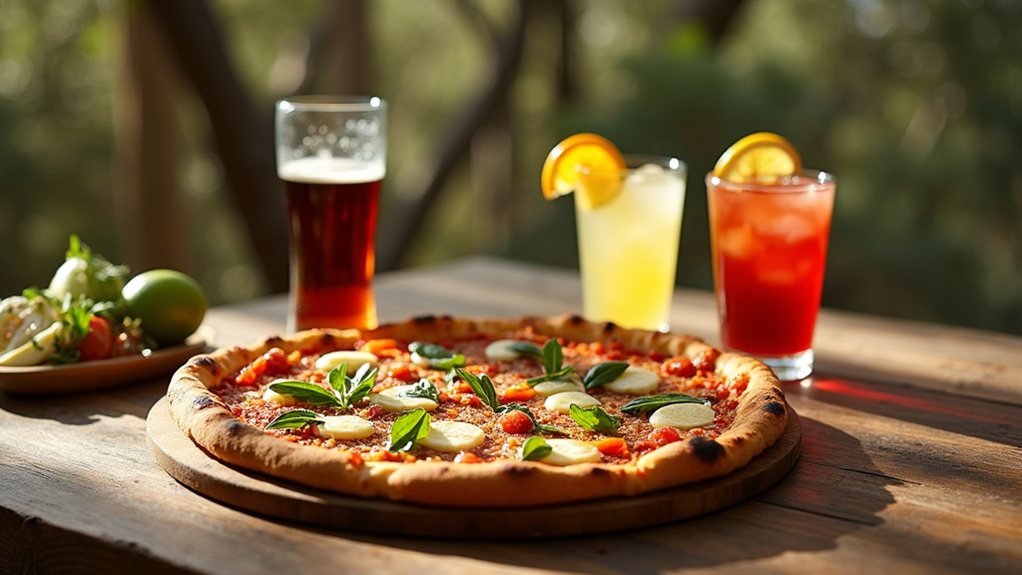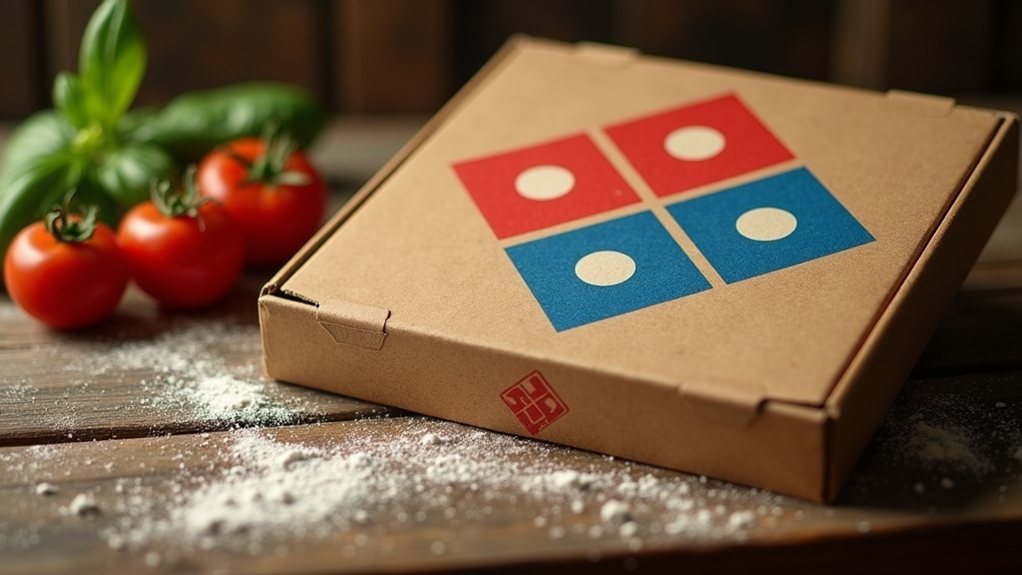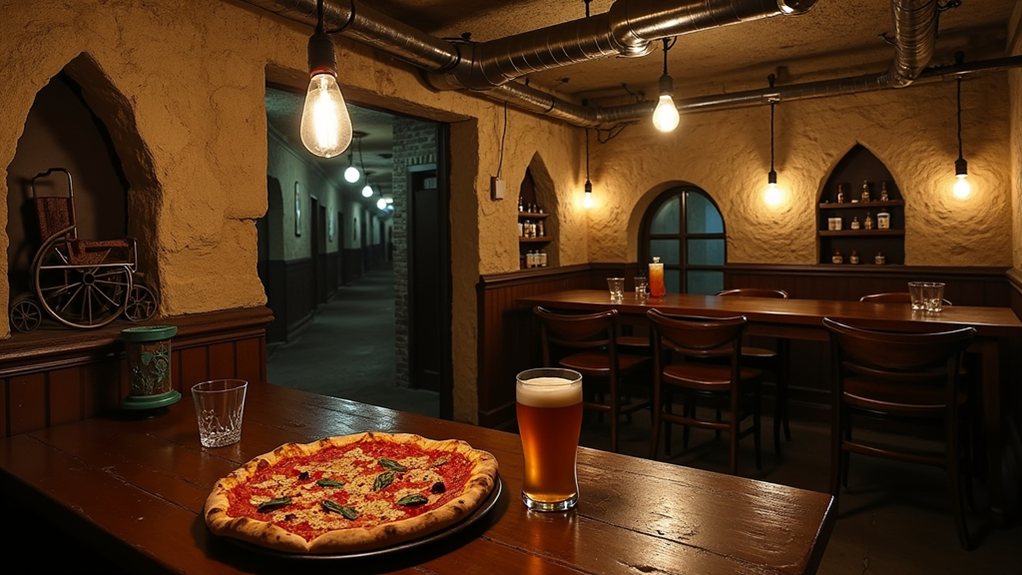Canadian pizza stands as a distinctive culinary creation, blending traditional Italian foundations with singularly northern influences. Regional variations appear across provinces, from Quebec's poutine-inspired toppings to Alberta's game meats. The "All Dressed" pizza, originating in Montreal, represents this fusion perfectly with its combination of pepperoni, green peppers, and mushrooms. What truly sets Canadian pizza apart, however, is not just its ingredients but the cultural identity it represents—a reflection of Canada's diverse heritage that continues to evolve with each new flavor combination.
The Birth of Canadian Pizza: A Delicious History

While pizza enjoys worldwide popularity today, the story of Canadian pizza begins with the dish's humble origins in Naples, Italy, where the modern version with tomatoes emerged in the late 18th century.
This culinary tradition traveled across the Atlantic with Italian immigrants who settled in Canadian urban centers, establishing vibrant "Little Italy" neighborhoods in cities like Montreal and Toronto.
Canada's initial pizzeria opened its doors in Montreal in 1948, marking the beginning of a pizza transformation that would gain significant momentum during the post-WWII era. Unlike New York-style pizza, which traces its roots to 1905 when Lombardi's first opened, Canadian pizza establishments emerged several decades later.
Canada's pizza revolution began in 1948 Montreal, laying the foundation for its post-war culinary explosion.
Returning soldiers, having developed a taste for Italian cuisine during their service, helped fuel this growing popularity.
Throughout the 1950s, pizza evolved from a niche immigrant food into a mainstream Canadian favorite, with families adapting traditional recipes using local ingredients and innovative cooking methods. The most notable Canadian contribution to pizza culture came in the 1960s when a creative Greek-Canadian invented the now globally famous Hawaiian pizza.
What Makes a Pizza "Canadian": Classic Toppings and Combinations

As pizza evolved into a staple of Canadian cuisine after the 1950s, distinct topping combinations emerged that now symbolize the country's unique pizza identity. The most recognizable "Canadian" pizza features pepperoni, bacon, and mushrooms – a hearty trio that pairs savory meats with earthy fungi. This classic combination requires proper preparation to ensure mushrooms are dry before being added to the pizza. Many Canadians enjoy the regional adaptations that reflect cultural preferences across the country.
| Region | Signature Combination | Unique Feature |
|---|---|---|
| Montreal | "All Dressed" | Pepperoni, green peppers, mushrooms |
| Ottawa | Ottawa-Style | Toppings under cheese, sweet sauce |
| Windsor | Windsor-Style | Shredded pepperoni, canned mushrooms |
| Pictou County | Brown Sauce | Vegetable-based sauce instead of tomato |
Beyond these classics, innovative combinations continue to surface, including BBQ chicken pizzas and even poutine pizza, which incorporates Canadian comfort food directly onto a crust. Local ingredients like bison and Arctic char reflect Canada's diverse culinary landscape.
Canadian Bacon vs. American Bacon on Pizza

The terminology "Canadian bacon" often causes confusion among pizza enthusiasts who encounter it on menus across North America.
Unlike American bacon, which comes from pork belly and cooks to a crispy finish, Canadian bacon is cut from the leaner pork loin, resulting in round, ham-like slices with considerably less fat content. This difference in origin fundamentally changes how each performs on pizza.
Canadian bacon arrives pre-cooked and smoked at higher temperatures, giving it a milder, more ham-like flavor profile that pairs wonderfully with cheeses like Gruyere or cheddar. When prepared correctly, thin slices create a pleasant melting effect that enhances the overall pizza experience.
Though typically more expensive than traditional toppings, many pizzerias offer it as a premium option.
While American bacon delivers crunchiness and intense flavor, Canadian bacon provides a more subtle taste experience, making it an excellent canvas for complementary Mediterranean or Asian flavor combinations. Its lower fat content makes it an ideal choice for those seeking weight management options without sacrificing flavor.
From Hawaiian to Canadian: Canada's Pizza Innovation

Canadian culinary history took an unexpected turn in 1962 when Sam Panopoulos, working at the Satellite Restaurant in Chatham, Ontario, created what would become one of the world's most controversial pizza varieties.
Inspired by Chinese cuisine's sweet-savory combinations, Panopoulos topped his pizza with canned pineapple, naming it after the brand "Hawaiian." This innovation sparked global debates that continue today, with even Prime Minister Justin Trudeau weighing in on the discussion.
Beyond the famous Hawaiian pizza, Canada's multicultural landscape has fostered incredible pizza diversity nationwide.
Regional specialties showcase local ingredients like Atlantic seafood, Prairie game meats, and Quebec's poutine-topped creations. This spirit of experimentation reflects Canada's immigrant influences, with pizzerias merging Italian traditions with ingredients and flavors from around the world.
Regional Canadian Pizza Variations Across Provinces

Regional diversity across Canada's vast territory has given rise to distinct pizza styles that reflect each province's unique cultural heritage and local ingredients.
The Maritime provinces welcome seafood and donair toppings, with Halifax's famous sweetened condensed milk sauce and Nova Scotia's distinctive brown Pictou County Pizza sauce.
Quebec celebrates its cultural roots with poutine-topped pizzas featuring cheese curds and gravy, while Montreal's "all-dressed" pizza combines pepperoni, green peppers, and mushrooms on airy crust.
Ontario boasts incredible variety, from Windsor's shredded pepperoni to Toronto's thin-crust creations influenced by Vietnamese immigrants.
Western provinces incorporate regional specialties like bison meat and perogy toppings, while British Columbia's coastal influence brings fresh seafood onto pizza.
These provincial variations showcase how Canadians have adapted pizza to reflect their local tastes and available ingredients.
The Perfect Canadian Pizza Recipe
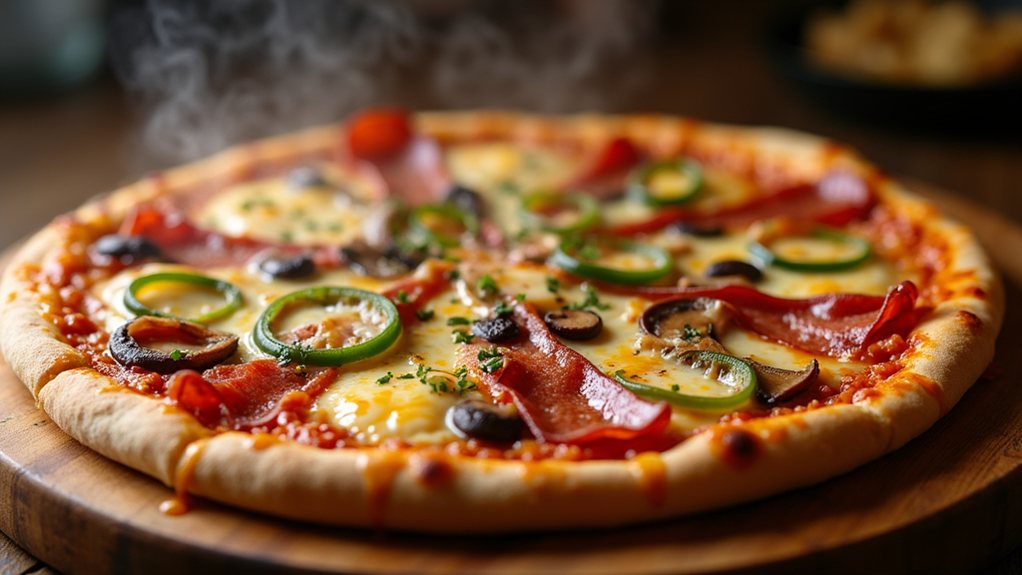
Having investigated the remarkable diversity of pizza styles across Canada's provinces, we can now examine how to create a quintessential Canadian pizza at home.
The foundation begins with a thin, crispy crust, which can be store-bought or homemade and works well baked on a stone.
Every great Canadian pizza masterpiece starts with a proper foundation — a thin, crispy crust that provides the perfect canvas for distinctly northern flavors.
For authentic Canadian flavor, combine mozzarella and sharp cheddar cheeses over a base of pizza sauce, perhaps improved with a touch of BBQ sauce.
The defining toppings include Canadian bacon (or back bacon), fresh mushrooms, and that distinctive maple syrup drizzle that balances sweet and savory profiles.
Optional additions like caramelized onions and green peppers add depth and texture, while fresh herbs serve as the perfect finishing touch.
Regional variations might incorporate poutine elements, butter chicken inspired by Canadian-Indian fusion, or coastal smoked salmon, depending on your preference.
Rising Stars: Unconventional Canadian Pizza Toppings
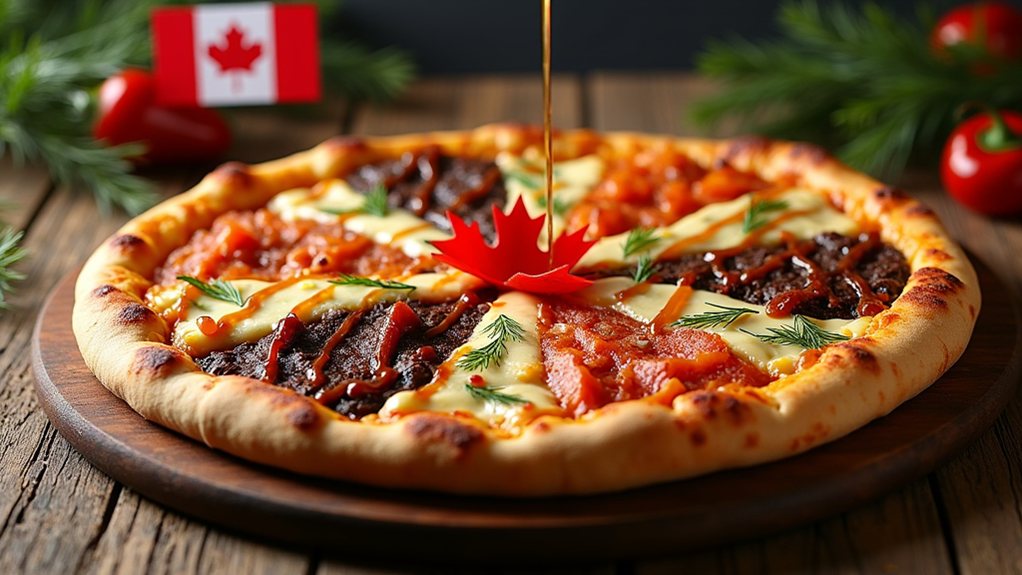
While traditional toppings have their devoted following, the true excitement in Canadian pizza culture comes from its boldly unconventional offerings that continue to push culinary boundaries. Across the country, pizzerias are experimenting with distinctively Canadian combinations that reflect the nation's diverse cultural landscape and regional specialties.
| Region | Signature Topping | What Makes It Special |
|---|---|---|
| Quebec | Poutine Pizza | Fries, cheese curds, and gravy create a comfort food fusion |
| Maritimes | Smoked Salmon | Coastal influence paired with cream cheese and dill |
| Alberta | Bison & Elk | Game meats offering rich, distinctive flavors |
| Ontario | Butter Chicken | Indian-Canadian fusion with creamy curry sauce |
| Nationwide | Maple Bacon | Sweet-savory combination that screams "Canada" |
Canadian Pizza Around the World
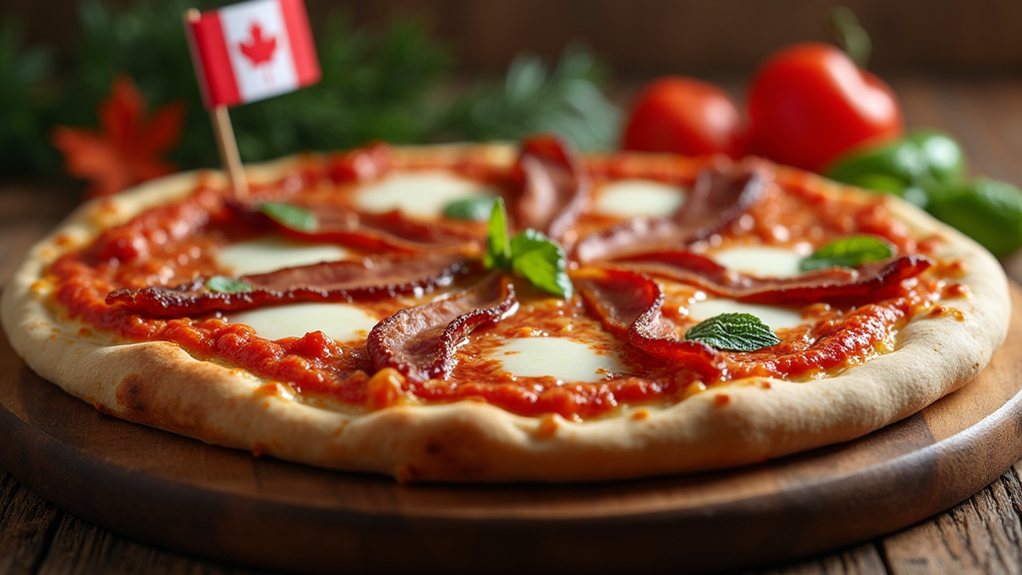
Canadian pizza culture has quietly made its mark on the international culinary scene, carrying its distinctive combinations of toppings beyond national borders. The unique blend of bacon, pepperoni, and mushrooms that characterizes Canadian Classic Pizza has found receptive audiences globally, appealing to those seeking new flavor experiences.
As the worldwide pizza market grows, Canadian-style pizzas have capitalized on the trend toward experimental toppings and diverse culinary influences. Restaurants abroad increasingly feature these North American creations, sometimes adapting them with local ingredients while maintaining their fundamental Canadian character.
This cross-cultural pizza exchange reflects broader global patterns of culinary fusion, where traditional dishes evolve through international influence. The future looks promising for Canadian pizza exports, as consumers worldwide continue to welcome innovative combinations that balance familiar comfort with exciting new flavor profiles.
Pairing Suggestions: What to Drink With Canadian Pizza

In regard to enhancing the enjoyment of a delicious Canadian pizza, choosing the right beverage can transform the dining experience from merely satisfying to truly memorable.
For Canadian pizza with its traditional bacon and mushroom toppings, a cool-climate Syrah offers a perfect match, complementing the smoky, savory elements without overwhelming them.
Beer enthusiasts might prefer a malty Märzen, which provides pleasant contrast to the saltiness of Canadian bacon.
For those who enjoy spirits, bourbon creates an interesting pairing, especially if maple is incorporated into the pizza's flavor profile.
When celebrating with friends, a bottle of Blanc de Blancs Champagne cuts through the richness of cheese and meat toppings.
Alternatively, for casual gatherings, a crisp pale lager serves as a revitalizing palate cleanser between bites of this North American favorite.
FAQs
Is Gluten-Free Canadian Pizza Available in Most Restaurants?
Gluten-free pizza is available in many Canadian restaurants, though availability varies by region. While popular chains offer these options, they often come with higher costs and potential cross-contamination risks.
How Many Calories Are Typically in a Slice of Canadian Pizza?
A slice of Canadian pizza typically contains between 220 to 330 calories, varying based on size and type of crust. Toppings like bacon and mozzarella influence the final caloric content.
What's the Best Way to Reheat Leftover Canadian Pizza?
For ideal reheating of leftover pizza, one may choose the oven method at 375°F for 10 minutes, stovetop with lid for a crispy-yet-melty result, or air fryer for quick 3-minute crispiness.
Are There Vegan Versions of Authentic Canadian Pizza?
Yes, authentic Canadian pizza has vegan counterparts. Brands like Yves offer plant-based pepperoni, while Daiya provides cheese alternatives. Major chains including Panago and Pizza 73 now feature these vegan options.
Can Canadian Pizza Be Shipped or Delivered Internationally?
International shipping of Canadian pizza presents significant challenges. While some local delivery services exist, regulatory hurdles, freshness concerns, and high costs generally make it impractical for global consumers seeking this unique culinary experience.

